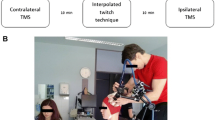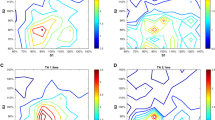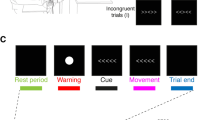Abstract
When attempting to perform two tasks simultaneously, the human motor as well as the cognitive system shows interference. Such interference often causes altered activation of the cortical area representing each task compared to the single task condition. We investigated changes in corticospinal inhibition during dual action by transcranial magnetic stimulation (TMS). Single-pulse TMS was applied to the left motor cortex, triggered by right leg movement (tibialis anterior muscle) while the right abductor digiti minimi (ADM) muscle was moderately activated (10–20% of the maximal voluntary contraction). The background electromyography (EMG) activity of ADM was measured before and during the leg movement. The silent period (SP) and amplitude of motor evoked potential (MEP) following magnetic stimulation in active ADM were compared for the conditions with and without leg movement. The mean area of the rectified EMG activity of ADM did not alter, while the SP was significantly shortened during leg movement compared to that without leg movement. MEP amplitude was comparable between the two conditions. These results suggest that corticospinal inhibition tested by the SP duration is reduced during the movement of another body part, presumably in order to help maintain muscle force by compensating interference-related alteration in motor cortical activation.



Similar content being viewed by others
References
Dai TH, Liu JZ, Sahgal V, Brown RW, Yue GH (2001) Relationship between muscle output and functional MRI-measured brain activation. Exp Brain Res 140:290–300
Debaere F, Swinnen SP, Beatse E, Sunaert S, Van Hecke P, Duysens J (2001) Brain areas involved in interlimb coordination: a distributed network. NeuroImage 14:947–958
Dettmers C, Connelly A, Stephan KM, Turner R, Friston KJ, Frackowiak RS, Gadian DG (1996) Quantitative comparison of functional magnetic resonance imaging with positron emission tomography using a force-related paradigm. NeuroImage 4:201–209
Donchin O, Gribova A, Steinberg O, Bergman H, Vaadia E (1998) Primary motor cortex is involved in bimanual coordination. Nature 395:274–278
Donchin O, Gribova A, Steinberg O, Bergman H, Cardoso de Oliveira S, Vaadia E (2001) Local field potentials related to bimanual movements in the primary and supplementary motor cortices. Exp Brain Res 140:46–55
Fuhr P, Agostino R, Hallett M (1991) Spinal motor neuron excitability during the silent period after cortical stimulation. Electroen Clin Neuro 81:257–262
Garvey MA, Ziemann U, Becker DA, Barker CA, Bartko JJ (2001) New graphical method to measure silent periods evoked by transcranial magnetic stimulation. Clin Neurophysiol 112:1451–1460
Inghilleri M, Berardelli A, Cruccu G, Manfredi M (1993) Silent period evoked by transcranial stimulation of the human cortex and cervicomedullary junction. J Physiol 466: 521–534
Nilsson J, Panizza M, Arieti P (1997) Computer-aided determination of the silent period. J Clin Neurophysiol 14:136–143
Oda S, Moritani T (1995) Movement-related cortical potentials during handgrip contractions with special reference to force and electromyogram bilateral deficit. Eur J Appl Physiol O 72:1-5
Pashler H (1994) Dual-task interference in simple tasks: data and theory. Psychol Bull 116:220–244
Pfadt A, Wheeler DJ (1995) Using statistical process control to make data-based clinical decisions. J Appl Behav Anal 28:349–370
Siebner HR, Dressnandt J, Auer C, Conrad B (1998) Continuous intrathecal baclofen infusions induced a marked increase of the transcranially evoked silent period in a patient with generalized dystonia. Muscle Nerve 21:1209–1212
Sohn YH, Hallett M (2004) Surround inhibition in human motor cortex. Exp Brain Res 158:397–404
Sohn YH, Kaelin-Lang A, Jung HY, Hallett M (2001) Effect of levetiracetam on human corticospinal excitability. Neurology 57:858–863
Swinnen SP (2002) Intermanual coordination: from behavioural principles to neural-network interactions. Nat Rev Neurosci 3:348–359
Taniguchi Y, Burle B, Vidal F, Bonnet M (2001) Deficit in motor cortical activity for simultaneous bimanual responses. Exp Brain Res 137:259–268
Thickbroom GW, Phillips BA, Morris I, Byrnes ML, Mastaglia FL (1998) Isometric force-related activity in sensorimotor cortex measured with functional MRI. Exp Brain Res 121:59–64
Triggs WJ, Cros D, Macdonell RA, Chiappa KH, Fang J, Day BJ (1993) Cortical and spinal motor excitability during the transcranial magnetic stimulation silent period in humans. Brain Res 628:39–48
Wu T, Sommer M, Tergau F, Paulus W (2000) Modification of the silent period by double transcranial magnetic stimulation. Clin Neurophysiol 111:1868–1872
Acknowledgements
We thank Devera G. Schoenberg, MSc, for skillful editing.
Author information
Authors and Affiliations
Corresponding author
Rights and permissions
About this article
Cite this article
Sohn, Y.H., Kang, S.Y. & Hallett, M. Corticospinal disinhibition during dual action. Exp Brain Res 162, 95–99 (2005). https://doi.org/10.1007/s00221-004-2109-5
Received:
Accepted:
Published:
Issue Date:
DOI: https://doi.org/10.1007/s00221-004-2109-5




